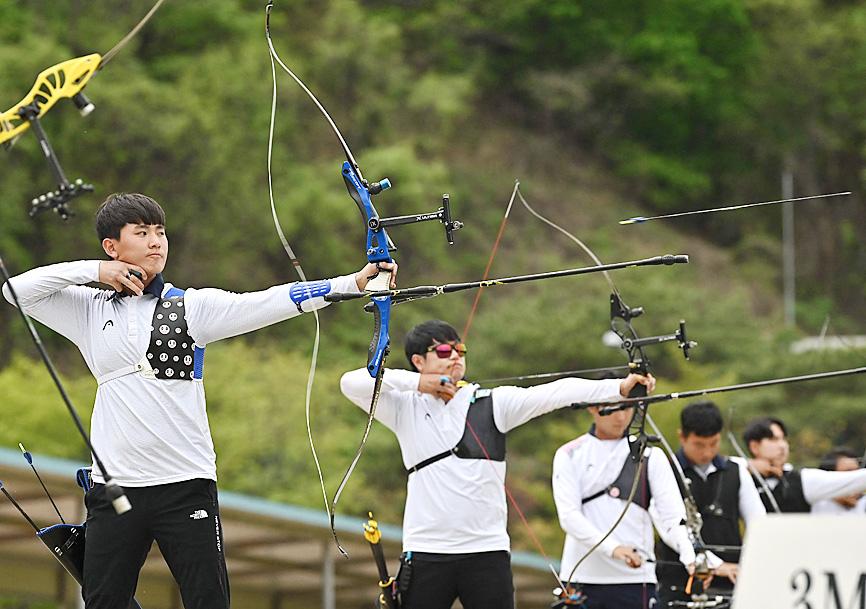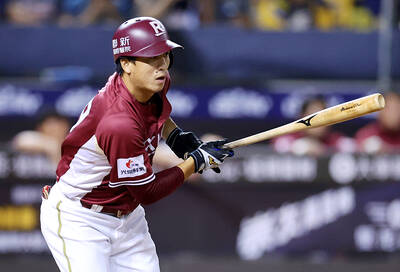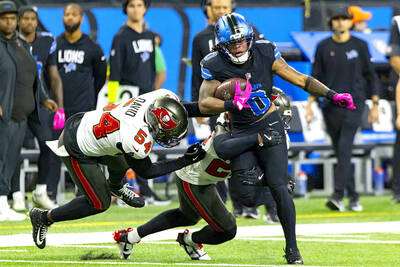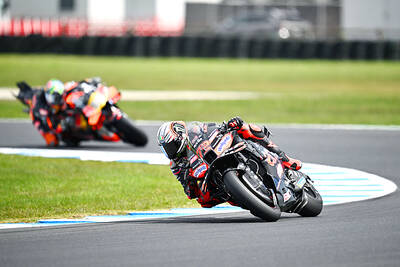Bungee jumping, baseball stadiums and a major automaker: The recipe for South Korea’s extraordinary dominance of Olympic archery is unorthodox, but pointedly effective.
South Korean archers have ruled the sport for decades, winning 23 out of the 34 Olympic golds awarded since 1984, including all four golds at the 2016 Rio de Janeiro Games.
The women have won all eight team titles since that discipline was added at the 1988 Seoul Games, while the men have taken five out of eight.

Photo: AFP
Theories abound as to why South Koreans are so good at archery, including vague mumblings about their “sensitive fingers” — a real or imagined physical trait also cited when discussing the nation’s dominance in women’s golf.
Archery is unusually lucrative in the country, with businesses and local governments owning more than 30 teams in competitive leagues and paying their members’ salaries — there are more than 140 professionals, the Korea Archery Association (KAA) said.
The country’s Olympic selection process is grueling and ruthless: The three male and female archers that are top ranked at multiple trials over several months get the slots, with no credit given for previous victories, records or standings.
“There is a saying that if you finish first in South Korea, you can win gold at the Olympics,” said Kim Hyung-tak, who coached the national team for the 1984 Los Angeles Games.
Even top stars can be cast aside in the relentless pursuit of gold. Among those representing South Korea in Tokyo will be a teenager and three women archers with no Olympic experience, while reigning Olympic champions Ku Bon-chan and Chang Hye-jin failed to make the team.
“It’s not that they’ve lost their skill,” KAA vice chairman Jang Young-sool said. “It just means that South Korea has many skilled archers.”
In the 1970s, as tension mounted on the Korean Peninsula, South Korea’s then-military government encouraged boys to train in taekwondo and girls to learn archery.
Kim trained dozens of teachers from schools across the nation so that they could instruct their pupils.
Archery lacked funding and needed facilities, Kim said, with competitions being held in drained swimming pools and results to match, despite a centuries-long tradition in the sport.
Ahead of the Seoul Games, then-South Korean president Chun Doo-hwan ordered the country’s major businesses to sponsor national sports federations to try to ensure a respectable performance.
The Hyundai Group was allocated archery, with a son of its founder becoming KAA chairman. The company has reportedly pumped at least US$40 million into the sport over the past three decades.
Top researchers from Hyundai have carried out scientific studies to improve the performance of archers, and Jang said that the firm’s long-term backing has been “essential.”
Hyundai Motor chairman Euisun Chung has been head of the KAA since 2005.
Jang credits him with the team’s success in Rio after he provided a customized bus equipped with beds, yoga mats and showers to ensure that the athletes were well-rested.
Chung was the first person that Ku Bon-chan ran to after winning the individual men’s gold, and the team showed their appreciation by tossing the Hyundai executive into the air.
The team has adopted unique training methods, ranging from bungee jumping, to control nerves, to practicing at a full baseball stadium, to handle the noise of large crowds.
Ahead of the 2012 London Games, they studied the British capital’s rain and wind patterns, and scoured South Korea for a training location with similar weather, finally picking Namhae on the often damp southern coast.
“The weather was actually terrible for the final match,” said Jang, who was head coach at the time. “The Chinese team were flustered, while our archers competed calmly and ended up winning by a single point.”
This year, the team has practiced at a replica of the arena in Tokyo, reproducing even the sounds the archers are expected to hear, from chirping birds to Japanese and English announcements.
First-time Olympian Kang Chae-young, 25, said that Tokyo would be “much more familiar,” as a result.
“I hope to be able to show my skills and do my best without any regrets,” she added.

The Rakuten Monkeys on Sunday downed the CTBC Brothers 2-1, handing the hosts their second consecutive loss in the best-of-seven CPBL Taiwan Series at the Taipei Dome. Monkeys’ ace starter Pedro Fernandez of the Dominican Republic dominated on the mound, cruising through six scoreless innings before giving up a run on a wild pitch in the bottom of the seventh inning. He gave up only three hits and walked two batters in a 93-pitch outing, giving his Taoyuan-based team an edge. Offensively, the Monkeys’ leadoff batter Lin Li hit Brothers starter Brandon Leibrandt’s pitch over the center-field wall in the game’s first at-bat,

The tiny village club of Mjallby AIF on Monday won the top tier Swedish soccer league with a 2-0 away win at IFK Gothenburg, sealing the title with three rounds of matches remaining. Jacob Bergstrom and Tom Pettersson scored the goals in Mjallby’s 20th win in 27 league games. Mjallby has a population of fewer than 1,400 people and plays in an outdated 6,000-seat stadium with stands weathered by the winds of the Baltic Sea. “It’s a huge relief to experience this now, a relief with three games to go,” said Anders Torstensson, a former army officer and secondary-school teacher who coaches the

Jahmyr Gibbs was offered oxygen on the bench after a 78-yard run. He turned it down. Clearly, he was not out of breath. Gibbs on Monday scored on a long sprint in the second quarter, a five-yard spinning plunge in the third and accounted for a career-high 218 yards from the scrimmage to lead the Detroit Lions in a 24-9 win over the Tampa Bay Buccaneers. “You felt like this was coming,” Detroit coach Dan Campbell said. “This has been building.” The Lions (5-2) bounced back from a loss as they have done flawlessly for nearly three years, extending their NFL-long streak of 51 games

Marco Bezzecchi yesterday demolished the Australian MotoGP lap record in setting the standard during second practice, becoming the first rider ever to dip below 1 minute, 27 seconds at Phillip Island. The Italian, who won the Indonesia sprint race two weeks ago before slamming into world champion Marc Marquez during the grand prix, blazed around the waterfront circuit in 1 minute, 26.580 seconds on his Aprilia. His time shattered the previous best of 1 minute, 27.246 seconds set by Jorge Martin in 2023. Not content with that, he then bettered it with a sizzling 1 minute, 26.492 seconds. That left Bezzecchi 0.291 seconds